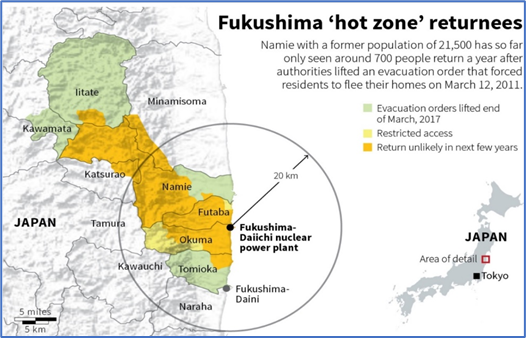Why in news?
- As part of a decommissioning project, Japan is expected to start flushing 1.25 million tonnes of wastewater from its Fukushima nuclear power plant into the Pacific Ocean this year.
- Experts are sceptical about this idea due to its suspected impact on the water, marine life, fishers’ livelihoods and other countries in the area.
What’s in today’s article?
News Summary
What was Fukushima nuclear disaster?

- In March 2011, after a magnitude 9 earthquake, a tsunami flooded the Fukushima Daiichi nuclear power plant in Okuma and damaged its diesel generators.
- The loss of power suspended coolant supply to reactors at the facility; the tsunami also disabled backup systems. This lead to Fukushima disaster.
- Soon, radioactive materials leaked from reactor pressure vessels, exploded in the facility’s upper levels, and exposed themselves to the ambient air, water, soil, and local population.
- Winds also carried radioactive material thrown up in the air into the Pacific.
- Since then, the power plant and its surrounding land have been uninhabitable.
What does Japanese government want?
- The water that the Japanese government wants to flush from the plant was used to cool the reactors, plus rainwater and groundwater.
- It contains radioactive isotopes from the damaged reactors and is thus itself radioactive.
- Japan has said that it will release this water into the Pacific Ocean over the next 30 years.
- Nuclear plants around the world regularly release water containing trace amounts of radionuclides into large waterbodies.
- For this, water is being treated to remove most radioactive isotopes. This water will be far above safety standards.
Why this move of Japanese govt is being opposed?
- No known threshold
- Japanese officials claim that the water will be treated before its release. However, experts claim that there is no known threshold below which radiation can be considered safe.
- Any discharge of radioactive materials will increase the risk of cancer and other health impacts to those who are exposed.
- Difficult to remove tritium from the water
- Removing tritium from the water is a very difficult task.
- Tritium, (T, or 3H), the isotope of hydrogen with atomic weight of approximately 3.
- But removal of tritium is necessary as it is easily absorbed by the bodies of living beings and rapidly distributed via blood.
- Impact on marine lives and livelihoods of the fisherfolk in the region
- Experts expect the affected water to poison the fish.
- South Korea banned seafood imported from around Fukushima, to Japan’s displeasure, from 2013.
- Impact on Pacific Ocean
- China, South Korea, Taiwan and Pacific Islands Forum have expressed concerns over this.
- Researchers across the world have also called for more studies to understand the precise composition of each tank before it is flushed.
What are Japan’s other options?
- Store the water for longer and then discharge it.
- This is because tritium’s half-life – the time it takes for its quantity to be halved through radioactive decay – is 12-13 years.
- The quantity of any other radioactive isotopes present in the water will also decrease in this time.
- So, at the time of discharge, the water could be less radioactive.










